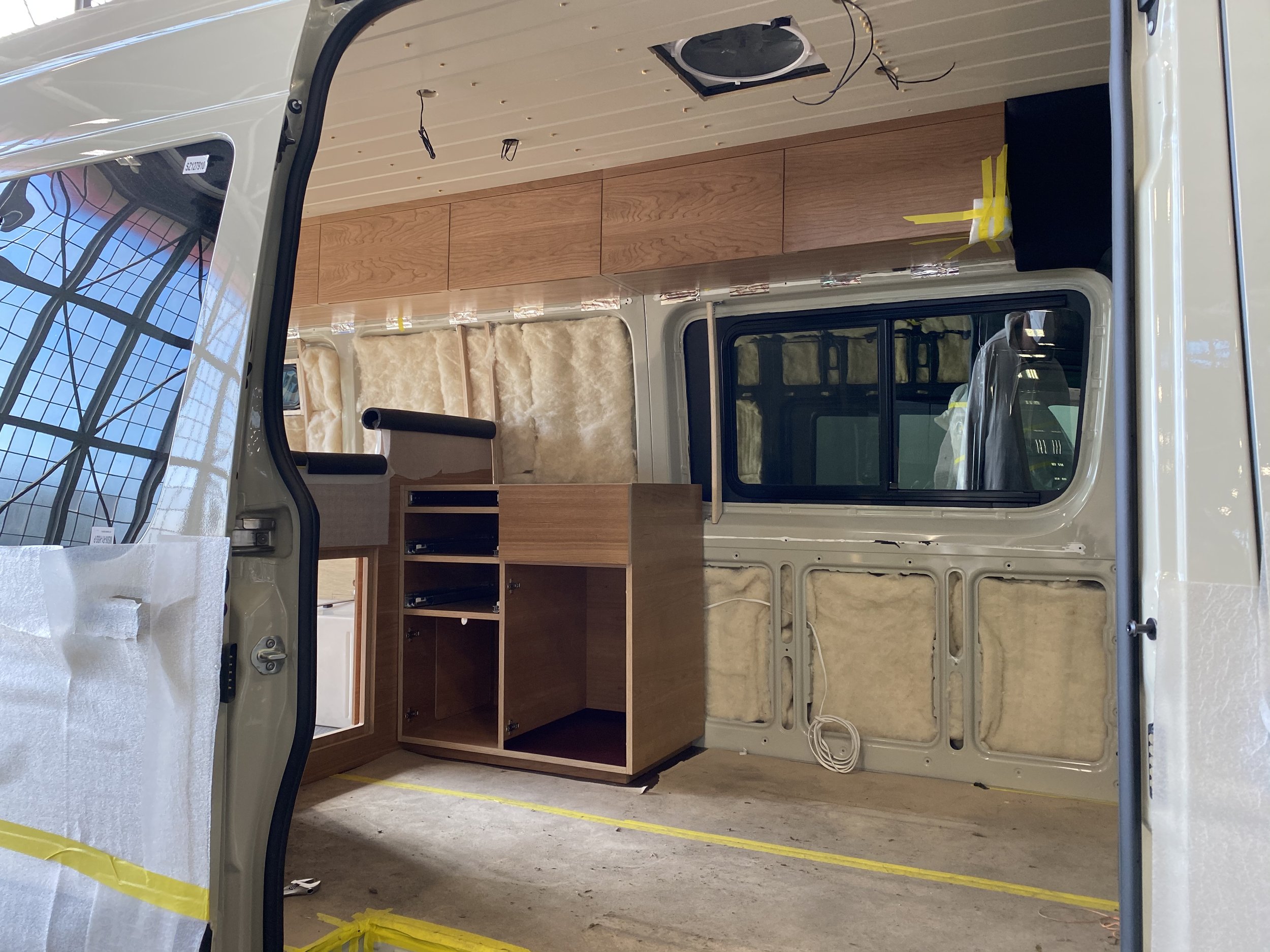How to Prevent Condensation in Your Camper Van
Photo by Vanlifers.com
Sprinter camper vans are a big investment, and just like other major purchases like a car or a house, it’s important to take steps to ensure their longevity. Whether you already own a Sprinter van or are currently looking into buying one, condensation is one of the major threats to a van’s durability and safety that you should be aware of.
In this article, we will explain how condensation forms and why it is so often an issue in camper vans, what can happen if you allow condensation to form in your van, and how to best protect your precious Sprinter camper van against condensation!
What is Condensation?
Condensation occurs when water droplets form on cold surfaces. A classic example of condensation is the water droplets that accumulate on a cold can of beer when you take it out of the fridge. But why were those droplets not already there when the beer was inside the fridge?
The answer lies in the fact that warm air can hold more moisture than cold air. When warm, water vapor-filled air comes into contact with a relatively cold surface such as the outside of a cold beer can, the air in contact with the can cools down and can no longer hold as much water vapor–so it releases the vapor in liquid form onto the surface of the can.
The collection of liquid on a cold surface in a relatively warm environment is what we know as condensation.
How Does Condensation Form in a Camper Van?
Your van is not a beer can, but when it comes to condensation, it can act very much like one! Camper vans are ideal environments for the formation of condensation because large temperature and moisture-level differences can occur between the inside of the van and the outside.
When it is cold outside, the metal surface of the van also becomes cold. Condensation can form on the inside of this metal surface when the humidity rises inside of the van. Because humidity (amount of water vapor in the air) naturally rises with temperature, a simple temperature difference between the inside and outside of your Sprinter van can lead to the formation of condensation!
A Sprinter camper van is the perfect environment for condensation to form because there are so many things that can raise the temperature and humidity inside of the van. Even just sleeping in your van on a cold night can cause condensation, because your body releases heat and your breath releases water vapor into the air. Additionally, cooking, boiling water, and using certain types of heaters can all lead to condensation in a van.
Why is Condensation in a Sprinter Van Bad?
So, we’ve established that condensation exists and that it can form easily on the inside of your van–but what’s the big deal? Aren’t we just talking about a tiny layer of water droplets? Many people are surprised to learn that condensation can lead to huge issues in a van. These include:
Mold: Where there’s moisture and no direct sunlight, there’s mold. If moisture builds up in hidden areas of a camper van, it can saturate surrounding materials and lead to mold growth. Depending on the specifics of the build, all of this can happen completely out of sight, behind cabinets, walls, and flooring. Some types of mold, including “black mold” are extremely harmful if their spores are inhaled or ingested. It is not unheard of for vandwellers to become sick, only to find that the culprit is black mold growing inside of their van!
Rot: When condensation forms in a van consistently over a long period of time, it can lead to the degradation of materials used in the build. When untreated or unsealed wood becomes logged with water, it not only becomes a perfect environment for mold to form, but it also begins to break down and rot. Over time, van builds can quite literally fall apart due to water exposure and rot from condensation.
Rust: Wood isn’t the only material that does not mix well with water. Exposed metal surfaces are prone to rust. This means that your van itself can literally begin to rust from the inside out due to condensation build-up. Rust spread is difficult to stop once it begins, and repairs are extremely costly.
Photo by Muse & Co. Outdoors
How Can Condensation be Prevented in a Sprinter Van?
By now you should be wondering: “How can I be absolutely sure that condensation will not be a problem in my van?” Fortunately, condensation and its resulting issues are completely preventable. It takes some forethought, a bit of diligence, and the right materials and components to protect your van against condensation. Here are the best ways to prevent moisture build-up inside of your van:
Insulation Done Right
Insulation is the single most important factor when it comes to condensation prevention in a van build. In addition to regulating the temperature inside of your van, insulation is critical in mitigating the moisture that can form as well. Insulation creates a temperature barrier between the inside and outside of your van, which can eliminate the primary effect that causes condensation build-up: warm air from the van meeting a cold surface such as a window or the van’s metal.
Certain types of insulation go above and beyond in controlling moisture inside of your van. Muse & Co. Outdoors vans utilize Havelock Wool insulation. Havelock Wool is an all natural, sustainably-sourced sheep’s wool insulation with excellent temperature-regulating properties. But wool has a unique advantage when it comes to condensation. This material naturally absorbs water as the air around it becomes more saturated, then slowly releases the moisture back into the air as the humidity decreases.
Vans that are thoroughly insulated with Havelock Wool are extra protected against the dangers of condensation build-up, as this material will not only prevent condensation from forming, but will also wick away any extra moisture that does manage to form.
Of course, windows are one area of a van that cannot be permanently insulated. To prevent condensation build-up on your windows, we recommend investing in a set of custom-fit insulated window covers for your Sprinter van. Muse & Co. Outdoors offers these covers as a part of our “Winter Package”
“Dry” Heat
As we mentioned above, heaters are one of the primary sources of condensation in camper vans. But the type of heater being used is very important. Some people use portable propane heaters in their vans. These are your worst enemy when it comes to condensation. Not only will humidity naturally rise as the temperature increases inside of the van, but burning propane also releases water into the air. Furthermore, these types of heaters will lead to CO build-up and can be very dangerous when used in a van.
Fortunately, there is a solution for providing safe, thermostat-controlled, on-demand heat in a camper van in a way that does not lead to condensation build-up. Muse & Co. Outdoors vans utilize externally-vented diesel heaters, which use the van’s diesel tank as a fuel source and bring in fresh air from outside the van before heating it up. They also expel the “exhaust” from the heater outside your van, so you can safely heat your van with all the windows closed.
Photo by Muse & Co. Outdoors
Ventilation
The reason that some heaters, such as the Espar D2 used in Muse & Co. Outdoors vans, lead to less condensation build-up is because they create ventilation to the outside of the van. Ventilation is critical to preventing condensation because it mixes the moist air inside of your van with drier air from outside.
In some cases, such as while you are cooking, it is important to have ways to provide good ventilation in your van without running your heater. Roof fans which can either pull air into the van through open windows, or push it in through the fan vent opening itself, are a must-have in camper vans. In addition to preventing condensation, ventilation fans keep your van’s air fresh–which is critical when you are sleeping, cooking, and living in one tiny space. All Muse & Co. Outdoors vans are hand-crafted with longevity and durability in mind. As the Bay Area’s top Sprinter van conversion company, we take extra steps to ensure that our vans are protected against condensation and other hazards. Take a look at our models and give us a call to learn more!



